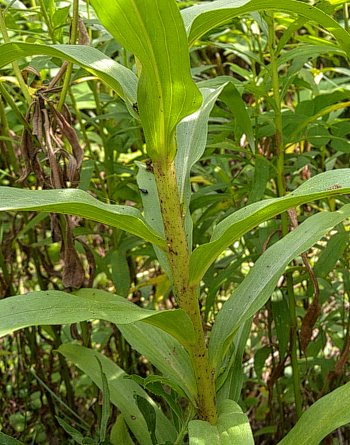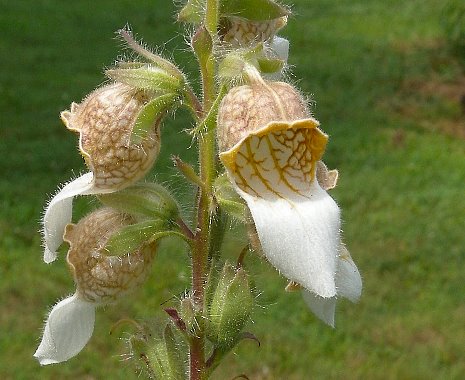 Description:
This wildflower is a biennial or short-lived perennial.
During the first year, it forms a low rosette of basal leaves. The
basal leaves are up to 6" long and 2" across; they are lanceolate,
oblanceolate, or elliptic in shape and usually smooth (entire) along
their
margins. Both the lower and upper surfaces of these leaves are dull
green and glabrous. During the second year and thereafter, an erect
flowering stalk develops that is 2-4' tall and unbranched. The lower
half of the stalk is light green, yellowish green, or purple, terete,
and glabrous; sometimes their are purple or brown dots on light-colored
stalks. Spreading to slightly drooping alternate leaves occur along the
lower stalk that are up to 8" long and 1½" across. The alternate leaves
are lanceolate-oblong in shape, smooth along their margins, and
sessile or nearly so. The lower and upper surfaces of these leaves are
dull green and glabrous. The primary veins of both basal and alternate
leaves are parallel. The stalk terminates in a spike-like raceme
of flowers about 1-2' tall. The flowers are densely arranged along the
raceme and they are oriented in all directions. The upper half of the
stalk (or axis of the raceme) is light green, yellowish green, or
purple, terete, and more or less glandular-hairy. Individual flowers
are about 1¼-2" long. Each flowers consists of a broad tubular corolla
with 5 lobes, a calyx with 5 sepals, 4 stamens, and a pistil with a
long style. The corolla tube is pale cream to yellowish green with an
intricate network of brown or purple veins; its exterior is finely
pubescent. The two upper lobes and two
lateral lobes along the outer rime of the corolla are small in size and
curve backward. The lower lobe is much larger in size (about ½-¾"
long) than the other lobes; it is bright white and curves downward. The
stamens and style are located along the upper surface of the corolla's
interior. The sepals are light green, linear-lanceolate, hairy, and
ciliate along their margins; they are about ½" long. The short pedicels
are green and hairy. Underneath the flowers, are individual leafy
bracts that are longer toward the bottom of the raceme than toward the
top; they are highly variable in length (from ¼" long above to 6" long
below). The leafy bracts are green, usually lanceolate-oblong in
shape, variably hairy, and sessile; their margins are smooth and often
ciliate. The blooming period occurs from late spring to mid-summer,
lasting about 1 month. Afterwards, the flowers are replaced by ovoid
seed capsules about ½" long that are green and hairy. At the apex of
each seed capsule, the persistent style of the flower becomes stiff and
hooked toward its tip. Each capsule contains numerous seeds. The root
system consists of a taproot. If a plant lives longer than 2 years, it
will die down to a rosette of basal leaves that persists during the
winter. It will develop another flowering stalk when warm weather
returns.
Description:
This wildflower is a biennial or short-lived perennial.
During the first year, it forms a low rosette of basal leaves. The
basal leaves are up to 6" long and 2" across; they are lanceolate,
oblanceolate, or elliptic in shape and usually smooth (entire) along
their
margins. Both the lower and upper surfaces of these leaves are dull
green and glabrous. During the second year and thereafter, an erect
flowering stalk develops that is 2-4' tall and unbranched. The lower
half of the stalk is light green, yellowish green, or purple, terete,
and glabrous; sometimes their are purple or brown dots on light-colored
stalks. Spreading to slightly drooping alternate leaves occur along the
lower stalk that are up to 8" long and 1½" across. The alternate leaves
are lanceolate-oblong in shape, smooth along their margins, and
sessile or nearly so. The lower and upper surfaces of these leaves are
dull green and glabrous. The primary veins of both basal and alternate
leaves are parallel. The stalk terminates in a spike-like raceme
of flowers about 1-2' tall. The flowers are densely arranged along the
raceme and they are oriented in all directions. The upper half of the
stalk (or axis of the raceme) is light green, yellowish green, or
purple, terete, and more or less glandular-hairy. Individual flowers
are about 1¼-2" long. Each flowers consists of a broad tubular corolla
with 5 lobes, a calyx with 5 sepals, 4 stamens, and a pistil with a
long style. The corolla tube is pale cream to yellowish green with an
intricate network of brown or purple veins; its exterior is finely
pubescent. The two upper lobes and two
lateral lobes along the outer rime of the corolla are small in size and
curve backward. The lower lobe is much larger in size (about ½-¾"
long) than the other lobes; it is bright white and curves downward. The
stamens and style are located along the upper surface of the corolla's
interior. The sepals are light green, linear-lanceolate, hairy, and
ciliate along their margins; they are about ½" long. The short pedicels
are green and hairy. Underneath the flowers, are individual leafy
bracts that are longer toward the bottom of the raceme than toward the
top; they are highly variable in length (from ¼" long above to 6" long
below). The leafy bracts are green, usually lanceolate-oblong in
shape, variably hairy, and sessile; their margins are smooth and often
ciliate. The blooming period occurs from late spring to mid-summer,
lasting about 1 month. Afterwards, the flowers are replaced by ovoid
seed capsules about ½" long that are green and hairy. At the apex of
each seed capsule, the persistent style of the flower becomes stiff and
hooked toward its tip. Each capsule contains numerous seeds. The root
system consists of a taproot. If a plant lives longer than 2 years, it
will die down to a rosette of basal leaves that persists during the
winter. It will develop another flowering stalk when warm weather
returns.
Cultivation: The preference is full or partial sun, mesic to dry-mesic conditions, and loamy soil, although other kinds of soil are readily tolerated. The size of flowering plants can vary considerably depending on soil fertility and the availability of moisture.
Range & Habitat: The non-native Grecian Foxglove rarely naturalizes in Illinois, where it has been found as an escaped plant in Champaign County (see Distribution Map). This species has also escaped in other states of the Midwest and Northeast in the United States, where it is also uncommonly naturalized. Grecian Foxglove is native to southeastern Europe in the Balkans region. It was introduced into North America as an ornamental and medicinal plant. Habitats of escaped plants include abandoned homesteads, areas along roadsides and railroads, weedy meadows, open woodlands, and areas near organic refuse dumps. Grecian Foxglove is still cultivated in gardens. Escaped plants of this species are typically found in disturbed areas near human settlements.

Faunal Associations: The flowers of Grecian Foxglove are cross-pollinated by nectar-seeking bumblebees. Because the foliage of this plant is highly toxic and bitter from cardiac glycosides, it is normally avoided by most mammalian herbivores. However, should it be consumed by cattle and other livestock, even small amounts of the foliage can be lethal. This also applies to humans. The hooked styles on the seed capsules can cling to the fur of passing mammals and the clothing of humans. In this manner, the seeds of this plant can be transported to new areas.
Photographic Location: Near an organic refuse dump at Meadowbrook Park in Urbana, Illinois.

Comments: Grecian Foxglove has large striking flowers that are oddly colored (by North American standards). In the past, it has been an important source of digoxin and other cardiac glycosides that are used in modern medicine to treat patients with various heart conditions. It is a dangerously toxic plant, however, and should not be used as a home remedy. Today, the cardiac glycosides of Grecian Foxglove and closely related species are used less often in modern medicine than they have in the past now that less risky medications have become available. Two other European species, Digitalis purpurea (Purple Foxglove) and Digitalis lutea (Yellow Foxglove), uncommonly naturalize in the Midwest and northeastern United States. They are readily distinguished by the appearance of their flowers: Purple Foxglove has flowers with bright purple corollas, while Yellow Foxglove has flowers with yellow corollas that lack the network of brown or purple veins that can be found on the corollas of Grecian Foxglove. So far, there are no records of these latter two species naturalizing in Illinois, even though they are both sometimes cultivated.